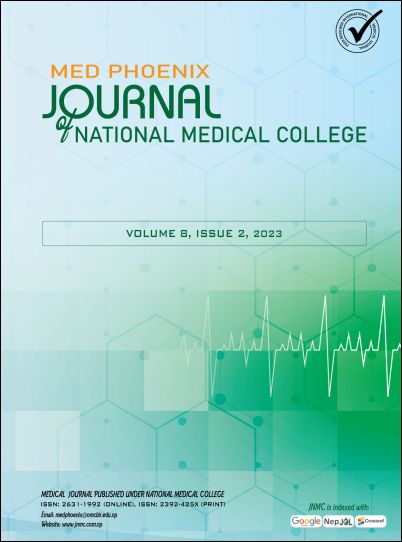Assessment of Functional Outcome of Humeral Diaphyseal Fractures Treated with Dynamic Compression Plate at National Medical College and Teaching Hospital, Birgunj, Nepal
DOI:
https://doi.org/10.3126/medphoenix.v8i2.61823Keywords:
Dynamic Compression Plate, Functional Outcome, Humerus Shaft Fracture, ReductionAbstract
Introduction: Fractures of the humeral shaft account for roughly 3-5% of all fractures and result from direct and indirect trauma. Common mechanism for this fractures include fall on the motor vehicle accidents, fall on out stretched hand and direct loads to the arm. The shaft of humerus fracture is managed largely conservatively, but with the advent of new surgical techniques and implant options, less tolerance for acceptable deformity and functional deficits, more time consuming with conservative management, many surgeon are increasingly likely to consider surgical management. The aim of our study is to assess the functional outcome of dynamic compression plate in shaft of humerus fracture.
Materials and Methods: This is a prospective observational study conductedm in department of orthopedic surgery, NMCTH, Birgunj among 45 patients from 17 years and above presenting with shaft of humerus fracture. The fracture was classified according to AO classification. The patients were treated with open reduction and internal fixation with dynamic compression plate and followed up at 2 weeks, 6 weeks, 12 weeks and 24 weeks till the radiological union was achieved. American shoulder and elbow surgeon’s scoring system was used to assess the final outcome of the study.
Results: 45 patients meeting inclusion criteria were included in the study, 3 patients lost follow up hence removed from study. Out of 42 patients, mean age of the patient was 31.95 years. Most of them 27(64.3%) were male. Predominant fracture was on left side 73.8% (31 patients). The study finding showed that 31(73.8%) sustained injury due to road traffic accidents. Majority of the fractures 32(76.20%) were in middle 1/3rd. Most of the patient had A3 type of fracture according to AO classification. The mean post-operative immobilization was 15 years. Forty one (97.61%) fracture united with one (2.39%) fracture going into non-union with mean time of 16.04 weeks. Thirty-seven (88.10%) patients has excellent range of motion of elbow and shoulder while 3(7.10%) had good and 2(4.8%) patient had poor functional outcome. The average ASES score obtained at 24 weeks was 47.07.
Conclusion: From our study, it is concluded that open reduction and internal fixation with DCP in shaft of humerus fracture provides excellent functional outcome.
Downloads
Downloads
Published
How to Cite
Issue
Section
License
Copyright (c) 2023 Med Phoenix

This work is licensed under a Creative Commons Attribution 4.0 International License.
Copyright on any research article is transferred in full to MED PHOENIX upon publication. The copyright transfer includes the right to reproduce and distribute the article in any form of reproduction (printing, electronic media or any other form).
© MEDPHOENIX
![]()
Articles in the MED PHOENIX are Open Access articles published under the Creative Commons CC BY License (https://creativecommons.org/licenses/by/4.0/). This license permits use, distribution and reproduction in any medium, provided the original work is properly cited.




